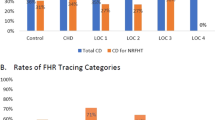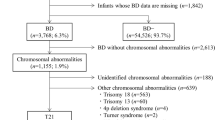Abstract
Objective
Newborns with trisomy 21 (T21) often require NICU hospitalization. Oxygen desaturations are frequently observed in these infants, even in the absence of congenital heart defects (CHD). We hypothesized that NICU patients with T21 have more hypoxemia than those without T21.
Design
All infants with T21 without significant CHD discharged home from the NICU between 2009 and 2018 were included (n = 23). Controls were matched 20:1 for gestational age and length of stay. We compared daily severe hypoxemia events (SpO2 < 80% for ≥10 s) for the whole NICU stay and the pre-discharge week.
Results
Infants with T21 showed significantly more daily hypoxemia events during their entire NICU stay (median 10 versus 7, p = 0.0064), and more so in their final week (13 versus 7, p = 0.0008).
Conclusion
NICU patients with T21 without CHD experience more severe hypoxemia events than controls, particularly in the week before discharge. Whether this hypoxemia predicts or contributes to adverse outcomes is unknown.
This is a preview of subscription content, access via your institution
Access options
Subscribe to this journal
Receive 12 print issues and online access
$259.00 per year
only $21.58 per issue
Buy this article
- Purchase on Springer Link
- Instant access to full article PDF
Prices may be subject to local taxes which are calculated during checkout



Similar content being viewed by others
References
Boghossian NS, Hansen NI, Bell EF, Stoll BJ, Murray JC, Laptook AR, et al. Survival and morbidity outcomes for very low birth weight infants with down syndrome. Pediatrics. 2010;126:1132–40.
Martin T, Smith A, Breatnach CR, Kent E, Shanahan I, Boyle M, et al. Infants born with down syndrome: burden of disease in the early neonatal period. J Pediatr. 2018;193:21–26.
Mann JP, Statnikov E, Modi N, Johnson N, Springett A, Morris JK. Management and outcomes of neonates with down syndrome admitted to neonatal units. Birth Defects Res Part A Clin Mol Teratol. 2016;106:468–74.
Ergaz-Shaltiel Z, Engel O, Erlichman I, Naveh Y, Schimmel MS, Tenenbaum A. Neonatal characteristics and perinatal complications in neonates with down syndrome. Am J Med Genet A. 2017;173:1279–86.
McAndrew S, Acharya K, Nghiem-Rao TH, Leuthner S, Clark R, Lagatta J. NICU management and outcomes of infants with trisomy 21 without major anomalies. J Perinatol. 2018;38:1068–73.
Waters KA, Castro C, Chawla J. The spectrum of obstructive sleep apnea in infants and children with down syndrome. Int J Pediatr Otorhinolaryngol. 2020;129:109763.
Wong W, Rosen D. Isolated mild sleep-associated hypoventilation in children with down syndrome. Arch Dis Child. 2017;102:821–4.
Colvin KL, Yeager ME. What people with down syndrome can teach us about cardiopulmonary disease. Eur Respir Rev. 2017;26:1–16.
Stanley MA, Shepherd N, Duvall N, Jenkinson SB, Jalou HE, Givan DC, et al. Clinical identification of feeding and swallowing disorders in 0–6 month old infants with down syndrome. Am J Med Genet A. 2019;179:177–82.
Nagraj VP, Sinkin RA, Lake DE, Moorman JR, Fairchild KD. Recovery from bradycardia and desaturation events at 32 weeks corrected age and NICU length of stay: an indicator of physiologic resilience? Pediatr Res. 2019;86:622–7.
Fairchild KD, Nagraj VP, Sullivan BA, Moorman JR, Lake DE. Oxygen desaturations in the early neonatal period predict development of bronchopulmonary dysplasia. Pediatr Res. 2019;85:987–93.
Poets CF. Intermittent hypoxia and long-term neurological outcome: How are they related? Semin Fetal Neonatal Med. 2020;25:101072.
Bush D, Galambos C, Ivy DD, Abman SH, Wolter-Warmerdam K, Hickey F. Clinical characteristics and risk factors for developing pulmonary hypertension in children with down syndrome. J Pediatr. 2018;202:212–19. e2
Shah PS, Hellmann J, Adatia I. Clinical characteristics and follow up of down syndrome infants without congenital heart disease who presented with persistent pulmonary hypertension of newborn. J Perinat Med. 2004;32:168–70.
Galambos C, Minic AD, Bush D, Nguyen D, Dodson B, Seedorf G, et al. Increased lung expression of anti-angiogenic factors in down syndrome: potential role in abnormal lung vascular growth and the risk for pulmonary hypertension. PLoS ONE. 2016;11:e0159005.
Weijerman ME, van Furth AM, van der Mooren MD, van Weissenbruch MM, Rammeloo L, Broers CJ, et al. Prevalence of congenital heart defects and persistent pulmonary hypertension of the neonate with down syndrome. Eur J Pediatr. 2010;169:1195–9.
Cua CL, Blankenship A, North AL, Hayes J, Nelin LD. Increased incidence of idiopathic persistent pulmonary hypertension in down syndrome neonates. Pediatr Cardiol. 2007;28:250–4.
Ramani M, Bradley WE, Dell’Italia LJ, Ambalavanan N. Early exposure to hyperoxia or hypoxia adversely impacts cardiopulmonary development. Am J Respir Cell Mol Biol 2015;52:594–602.
Horne RSC, Sakthiakumaran A, Bassam A, Thacker J, Walter LM, Davey MJ, et al. Children with down syndrome and sleep disordered breathing have altered cardiovascular control. Pediatr Res. 2020.
Martin RJ, Di Fiore JM, Macfarlane PM, Wilson CG. Physiologic basis for intermittent hypoxic episodes in preterm infants. Adv Exp Med Biol. 2012;758:351–8.
Das D, Medina B, Baktir MA, Mojabi FS, Fahimi A, Ponnusamy R, et al. Increased incidence of intermittent hypoxemia in the Ts65Dn mouse model of down syndrome. Neurosci Lett. 2015;604:91–96.
Cooney TP, Thurlbeck WM. Pulmonary hypoplasia in down’s syndrome. N Engl J Med. 1982;307:1170–3.
Bush D, Abman SH, Galambos C. Prominent intrapulmonary bronchopulmonary anastomoses and abnormal lung development in infants and children with down syndrome. J Pediatr. 2017;180:156–62. e1
Simpson R, Oyekan AA, Ehsan Z, Ingram DG. Obstructive sleep apnea in patients with down syndrome: current perspectives. Nat Sci Sleep. 2018;10:287–93.
Lee C-F, Lee C-H, Hsueh W-Y, Lin M-T, Kang K-T. Prevalence of obstructive sleep apnea in children with down syndrome: a meta-analysis. J Clin Sleep Med. 2018;14:867–75.
Southall DP, Stebbens VA, Mirza R, Lang MH, Croft CB, Shinebourne EA. Upper airway obstruction with hypoxaemia and sleep disruption in down syndrome. Dev Med Child Neurol. 1987;29:734–42.
Goffinski A, Stanley MA, Shepherd N, Duvall N, Jenkinson SB, Davis C, et al. Obstructive sleep apnea in young infants with down syndrome evaluated in a down syndrome specialty clinic. Am J Med Genet A. 2015;167A:324–30.
Coverstone AM, Bird M, Sicard M, Tao Y, Grange DK, Cleveland C, et al. Overnight pulse oximetry for evaluation of sleep apnea among children with trisomy 21. J Clin Sleep Med. 2014;10:1309–15.
Siriwardhana LS, Nixon GM, Davey MJ, Mann DL, Landry SA, Edwards BA, et al. Children with down syndrome and sleep disordered breathing display impairments in ventilatory control. Sleep Med. 2020;77:161–9.
O’Driscoll DM, Horne RSC, Davey MJ, Hope SA, Anderson V, Trinder J, et al. Cardiac and sympathetic activation are reduced in children with down syndrome and sleep disordered breathing. Sleep. 2012;35:1269–75.
Breslin J, Spanò G, Bootzin R, Anand P, Nadel L, Edgin J. Obstructive sleep apnea syndrome and cognition in down syndrome. Dev Med Child Neurol. 2014;56:657–64.
Lott IT. Antioxidants in down syndrome. Biochim Biophys Acta. 2012;1822:657–63.
Huggard D, Kelly L, Ryan E, McGrane F, Lagan N, Roche E, et al. Increased systemic inflammation in children with down syndrome. Cytokine. 2020;127:154938.
Pecze L, Randi EB, Szabo C. Meta-analysis of metabolites involved in bioenergetic pathways reveals a pseudohypoxic state in down syndrome. Mol Med. 2020;26:102.
Funding
NICHD R01HD072071.
Author information
Authors and Affiliations
Corresponding author
Ethics declarations
Conflict of interest
The authors declare no competing interests.
Additional information
Publisher’s note Springer Nature remains neutral with regard to jurisdictional claims in published maps and institutional affiliations.
Rights and permissions
About this article
Cite this article
Krahn, K.N., Nagraj, V.P., McCulloch, M.A. et al. Hypoxemia in infants with trisomy 21 in the neonatal intensive care unit. J Perinatol 41, 1448–1453 (2021). https://doi.org/10.1038/s41372-021-01105-7
Received:
Revised:
Accepted:
Published:
Issue Date:
DOI: https://doi.org/10.1038/s41372-021-01105-7
This article is cited by
-
Epigenomic signature of major congenital heart defects in newborns with Down syndrome
Human Genomics (2023)



